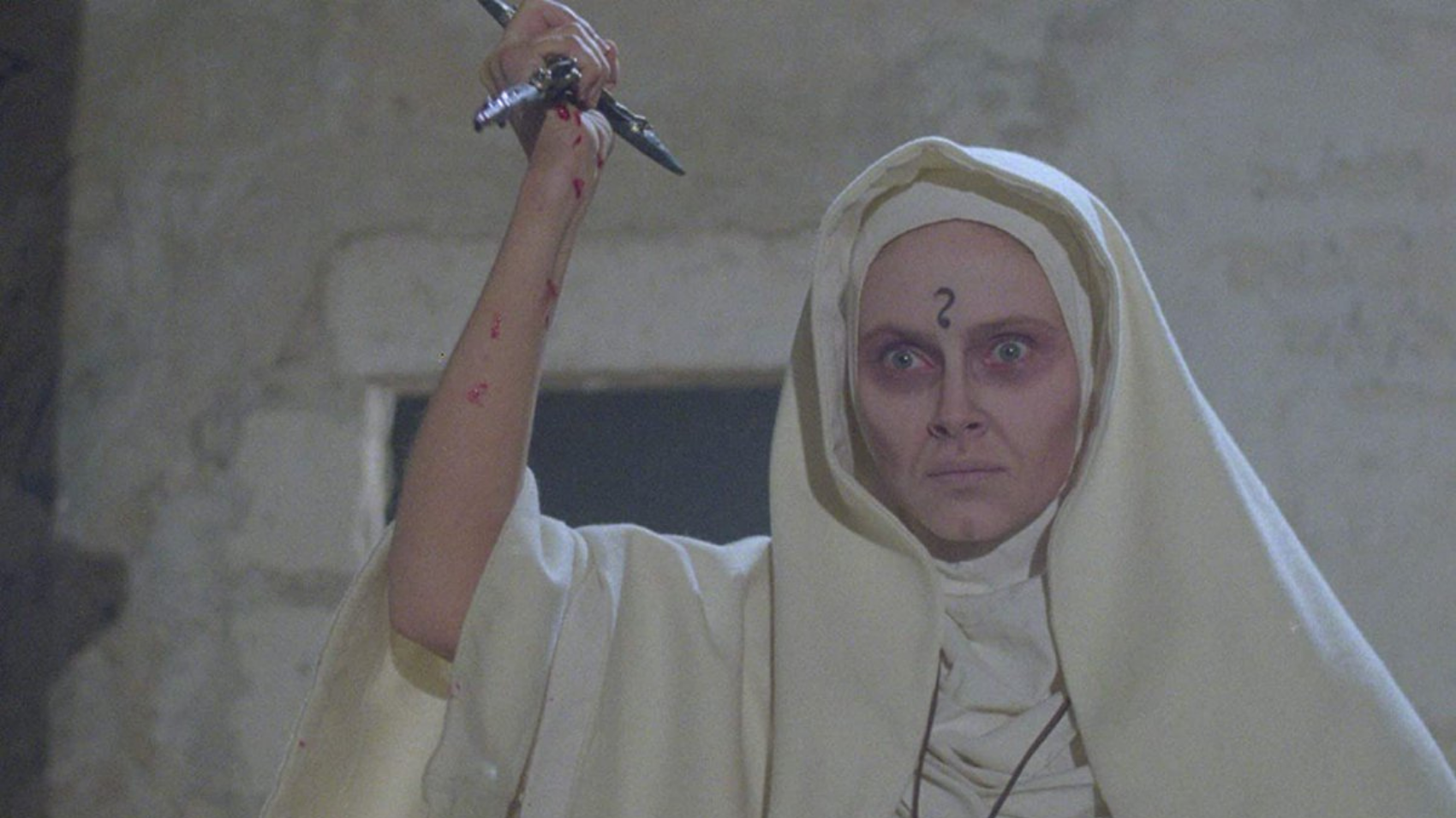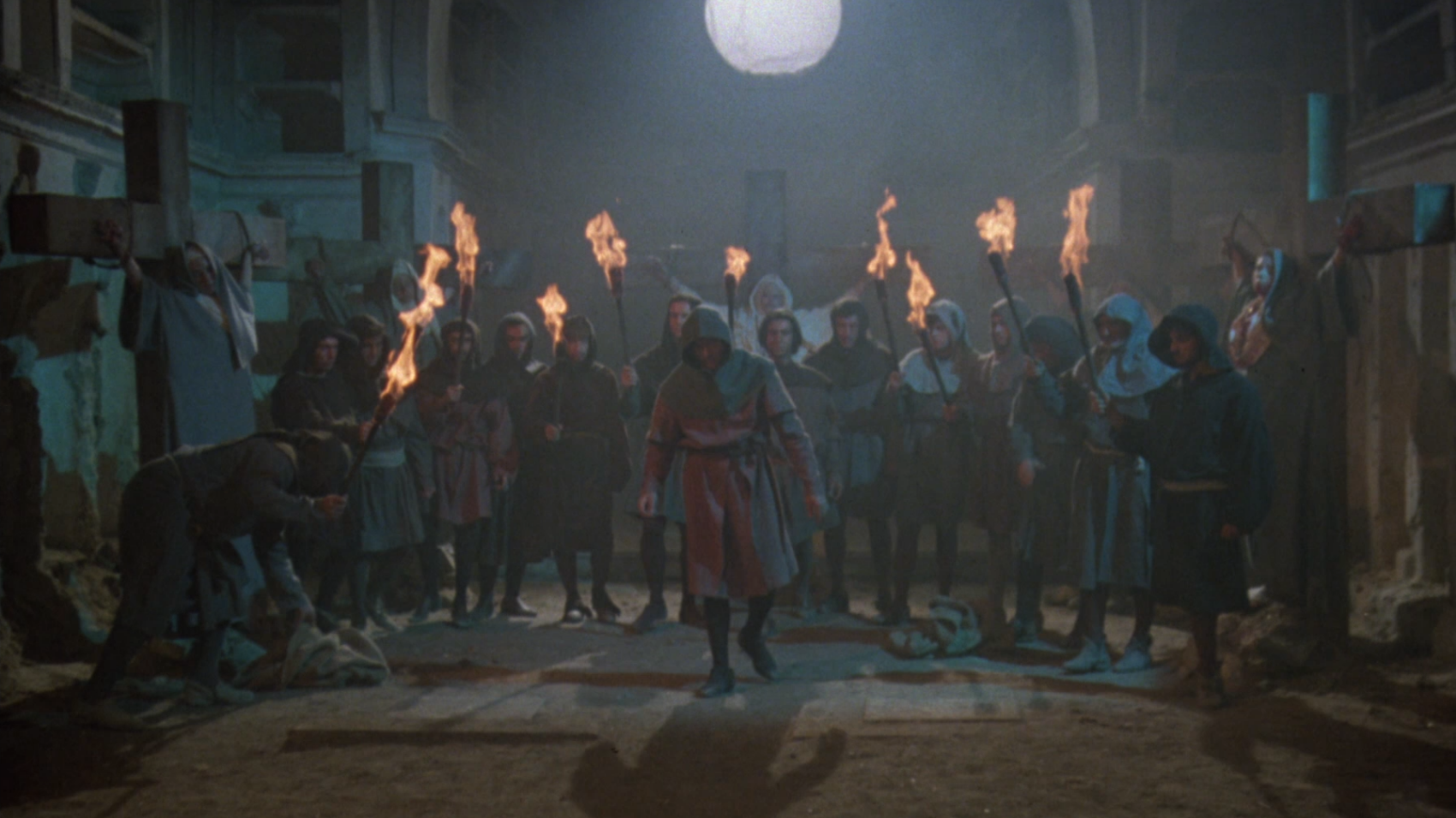[Film Review] Demonia (1990)

There’s a sequence in Demonia (1990) where the stark-naked ghost of a Medieval nun fires a harpoon gun into a man’s chest. For most directors, this would be the absolute peak of absurdity in their movie-making career; however, when it comes to the filmography of Italian horror maestro Lucio Fulci, this is nothing out of the ordinary. To Fulci, a sequence like this was simply known as “the average Thursday”.
Long-time fans of the horror genre will undoubtedly be familiar with the work of Lucio Fulci (1927-1996), a man referred to as “the Italian Godfather of Gore”. Though Fulci dabbled in many areas of genre film, his legacy lies in his lurid, grotesquely gorgeous horror features, titles which leapt out from the horror aisles of any good video store – provided they weren’t already banned, of course. During the ‘70s and ‘80s, Fulci would make audiences squirm in their seats with the notorious likes of Zombie Flesh Eaters (1979), City of the Living Dead (1980), and The New York Ripper (1982). Demonia is a latter-day addition to Fulci’s horror canon, released direct-to-video in 1990, and whilst it might not be nearly as renowned as the aforementioned titles, it lacks none of their bizarre, stylishly ultra-violent spirit.
The film follows a Canadian excavation team stationed in Sicily, led by the esteemed archaeologist Liza (Meg Register), and her former tutor, Professor Evans (Brett Halsey), tasked with surveying the ancient ruins around a crumbling Medieval monastery. Drawn by night-time visions of the horrors of the past, and in spite of the locals’ warnings, Liza decides to investigate what lies within the derelict priory; in doing so, she unearths a crypt containing the bodies of five devil-worshiping nuns, crucified by an angry mob and sealed away centuries prior. With their would-be final resting place disturbed, the malevolent spirits of the sinful sisters begin to pick off teammates and townsfolk alike in gruesome fashion; and, given this is a film made by a director whose arguably most famous work features a woman’s eyeball being pierced with a splinter in graphic detail, perhaps even the word “gruesome” is an understatement.

Demonia, being one of the later entries in Fulci’s cinematic career, could be described as a “greatest hits” of the master’s work; a premonition of doom during a séance, a vicious cat attack, and a memorable sequence of eye trauma all feature throughout the course of the film. Indeed, Demonia bears all the hallmarks of Fulci’s work; gorgeous location scenery, plenty of blood and guts, and a deeply questionable English-dubbed soundtrack. The location in question, the looming accursed monastery in which a good deal of the film takes place, is a true highlight; from its walls, lined with cobwebbed skeletons, to the intimidating gothic presence of its very structure, Demonia’s location feels so authentically dusty and decrepit that you barely even notice the film’s incredibly low budget – let alone the fact that it was never released theatrically. That being said, the film’s deeply debatable English voice work is more distracting than most of its ilk, and unlike some of its precursors, ‘a ‘la Zombie Flesh Eaters, the places where its pacing lulls often feel less hypnotic and dream-like, and more like mere padding between the supernatural hijinks and bloodshed in order to reach a feature length.
HAVE YOU LISTENED TO OUR PODCAST YET?
![[Ghouls Podcast] Maniac (2012) with Zoë Rose Smith and Iona Smith](https://images.squarespace-cdn.com/content/v1/5fe76a518d20536a3fbd7246/1696356006789-NYTG9N3IXCW9ZTIJPLX2/maniac.jpg)
Naturally, the gore scenes are exquisite. Are the seams of the admittedly cheap effects visible? Sure, but that means little in comparison to the sheer audacity and power of the imagery put on display here; the aforementioned “cat attack” scene is a diabolical delight, probably the most on-brand the “Godfather of Gore” has ever been, and a truly gut-churning image during the film’s climax (one which presages 2015’s Bone Tomahawk) is guaranteed to stick with me for a while. The way in which Fulci depicts violence is an art-form in itself, and whilst many dismiss his later work, there’s no denying that his handling of gruesome imagery is masterful here – provoking equally the urge to look away whilst also the urge to gaze onwards in transfixed terror.
It’s also a very funny film, though likely unintentionally so – its confoundingly strange nature makes that somewhat inevitable. In one scene, a character uses the phrase “the whole thing seems to slip through your fingers like a handful of eels”, only one of the many deeply peculiar lines littered throughout the film. When your film contains an angry mob clad entirely in double denim, a butcher being bludgeoned to death by swinging pieces of meat, and a little boy coated head-to-toe in what appears to be raspberry syrup, you can’t help but laugh a little. This is by no means a criticism of the film because its silliness brought me great joy – a film being goofy doesn’t necessarily make it bad, nor does it necessarily hinder its effectiveness as a work of horror fiction.

Of course, as with every horror film, there’s more to Demonia than just schlock and gore. The gender politics are truly fascinating, if relatively unexplored; the small town adjacent to the monastery appears to have an entirely male population, with the only woman in the area living as a hermit on the outskirts of town. There’s even a suggestion that the allegations of devil-worship at the convent were merely rumours concocted by men out of their fears of womanhood. Perhaps the murderous ghosts are more vengeful than sinister, innocents taking out their revenge against the patriarchal world that condemned and killed them? You could say that I’m reading too far into the implications of this silly direct-to-video demon nun splatter movie, and to that I respond – how can you watch a film where a burning nun vomits up mustard, and not consider it worthy of analysis and appraisal?
Demonia might be considered one of Lucio Fulci’s lesser works by some – but, I’ll be damned, it’s still Fulci, loud and proud, and that’s enough for me.

RELATED ARTICLES
When someone is in a toxic relationship, it can affect more than just their heart and mind. Their bodies can weaken or change due to the continued stress and unhappiness that comes from the toxicity.
Perpetrator opens with a girl walking alone in the dark. Her hair is long and loose just begging to be yanked back and her bright clothes—a blood red coat, in fact—is a literal matador’s cape for anything that lies beyond the beam of her phone screen.
When V/H/S first hit our screens in 2012, nobody could have foreseen that 11 years later we’d be on our sixth instalment (excluding the two spinoffs) of the series.
The best thing about urban legends is the delicious thrill of the forbidden. Don’t say “Bloody Mary” in the mirror three times in a dark room unless you’re brave enough to summon her. Don’t flash your headlights at a car unless you want to have them drive you to your death.
Filmed on location in Scotland, Ryan Hendrick's new thriller Mercy Falls (2023) uses soaring views of the Scottish Highlands to show that the natural world can either provide shelter or be used as a demented playground for people to hurt each other.
A Wounded Fawn (Travis Stevens, 2022) celebrates both art history and female rage in this surreal take on the slasher genre.
If you can’t count on your best friend to check your teeth and hands and stand vigil with you all night to make sure you don’t wolf out, who can you count on? And so begins our story on anything but an ordinary night in 1993…
If you know me at all, you know that I love, as many people do, the work of Nic Cage. Live by the Cage, die by the Cage. So, when the opportunity to review this came up, I jumped at it.

EXPLORE
Now it’s time for Soho’s main 2023 event, which is presented over two weekends: a live film festival at the Whirled Cinema in Brixton, London, and an online festival a week later. Both have very rich and varied programmes (with no overlap this year), with something for every horror fan.
In the six years since its release the Nintendo Switch has amassed an extensive catalogue of games, with everything from puzzle platformer games to cute farming sims to, uh, whatever Waifu Uncovered is.
A Quiet Place (2018) opens 89 days after a race of extremely sound-sensitive creatures show up on Earth, perhaps from an exterritorial source. If you make any noise, even the slightest sound, you’re likely to be pounced upon by these extremely strong and staggeringly fast creatures and suffer a brutal death.
If you like cults, sacrificial parties, and lesbian undertones then Mona Awad’s Bunny is the book for you. Samantha, a student at a prestigious art university, feels isolated from her cliquey classmates, ‘the bunnies’.
The slasher sub genre has always been huge in the world of horror, but after the ‘70s and ‘80s introduced classic characters like Freddy Krueger, Michael Myers, Leatherface, and Jason, it’s not harsh to say that the ‘90s was slightly lacking in the icon department.
Mother is God in the eyes of a child, and it seems God has abandoned the town of Silent Hill. Silent Hill is not a place you want to visit.
Being able to see into the future or back into the past is a superpower that a lot of us would like to have. And while it may seem cool, in horror movies it usually involves characters being sucked into terrifying situations as they try to save themselves or other people with the information they’ve gleaned in their visions.
Both the original Pet Sematary (1989) and its 2019 remake are stories about the way death and grief can affect people in different ways. And while the films centre on Louis Creed and his increasingly terrible decision-making process, there’s no doubt that the story wouldn’t pack the same punch or make the same sense without his wife, Rachel.


![[Ghouls Podcast] The Last House on the Left (2009) with Zoë Rose Smith and Jerry Sampson](https://images.squarespace-cdn.com/content/v1/5fe76a518d20536a3fbd7246/1687863043713-54DU6B9RC44T2JTAHCBZ/last+house+on+the+left.jpg)
![[Ghouls Podcast] The Bay (2012) with Ariel Powers-Schaub & Amber T](https://images.squarespace-cdn.com/content/v1/5fe76a518d20536a3fbd7246/1684751617262-6K18IE7AO805SFPV0MFZ/The+Bay+website+image.jpg)
![[Ghouls Podcast] Picnic at Hanging Rock (1975) with Zoë Rose Smith & Rebecca McCallum](https://images.squarespace-cdn.com/content/v1/5fe76a518d20536a3fbd7246/1682536446302-I2Y5IP19GUBXGWY0T85V/picnic+at+hanging+rock.jpg)
![[Ghouls Podcast] Psychotic Women in Horror with Zoë Rose Smith & Mary Wild](https://images.squarespace-cdn.com/content/v1/5fe76a518d20536a3fbd7246/1678635495097-X9TXM86VQDWCQXCP9E2L/Copy+of+Copy+of+Copy+of+GHOULS+PODCAST+THE+LOVED+ONES.jpg)
![[Ghouls Podcast] Nekromantik with Zoë Rose Smith & Rebecca McCallum](https://images.squarespace-cdn.com/content/v1/5fe76a518d20536a3fbd7246/1677422649033-Z4HHPKPLUPIDO38MQELK/feb+member+podcast.jpg)
![[Ghouls Podcast] Final Destination 5 & Wrap-up with Ariel Powers-Schaub & Iona Smith](https://images.squarespace-cdn.com/content/v1/5fe76a518d20536a3fbd7246/1672841326335-WER2JXX7WP6PO8JM9WB2/PODCAST+BONUS+2023+%284%29.jpg)
![[Ghouls Podcast] Final Destination 3 & 4 with Ariel Powers-Schaub & Iona Smith](https://images.squarespace-cdn.com/content/v1/5fe76a518d20536a3fbd7246/1672841151148-U152EBCTCOP4MP9VNE70/PODCAST+BONUS+2023+%283%29.jpg)
![[Ghouls Podcast] Final Destination 1 & 2 with Ariel Powers-Schaub & Iona Smith](https://images.squarespace-cdn.com/content/v1/5fe76a518d20536a3fbd7246/1672841181605-5JOOW88EDHGQUXSRHVEF/PODCAST+BONUS+2023+%282%29.jpg)
![[Ghouls Podcast] Henry: Portrait of a Serial Killer (1986)](https://images.squarespace-cdn.com/content/v1/5fe76a518d20536a3fbd7246/1672841247731-65K0JKNC45PJE9VZH5SB/PODCAST+BONUS+2023+%281%29.jpg)
![[Ghouls Podcast] A Serbian Film with Rebecca and Zoë](https://images.squarespace-cdn.com/content/v1/5fe76a518d20536a3fbd7246/1672841382382-RY0U5K7XD4SQSTXL2D14/PODCAST+BONUS+2023.jpg)
![[Editorial] Mini Podcast Episode: Do we still need the final girl?](https://images.squarespace-cdn.com/content/v1/5fe76a518d20536a3fbd7246/1645965559841-SZMV2JS4MVIHC86K4ALG/Screenshot+2022-02-27+at+12.36.12.png)
![[Film Review] Kill Your Lover (2023)](https://images.squarespace-cdn.com/content/v1/5fe76a518d20536a3fbd7246/1697465940337-T55VQJWAN4CHHJMXLK32/56_PAIGE_GILMOUR_DAKOTA_HALLWAY_CONFRONTATION.png)
![[Film Review] Perpetrator (2023)](https://images.squarespace-cdn.com/content/v1/5fe76a518d20536a3fbd7246/1695483561785-VT1MZOMRR7Z1HJODF6H0/Screenshot+2023-09-23+at+16.32.55.png)
![[Film Review] V/H/S/85 (2023)](https://images.squarespace-cdn.com/content/v1/5fe76a518d20536a3fbd7246/1697455043249-K64FG0QFAFVOMFHFSECM/MV5BMDVkYmNlNDMtNGQwMS00OThjLTlhZjctZWQ5MzFkZWQxNjY3XkEyXkFqcGdeQXVyMTUzMTg2ODkz._V1_.jpg)
![[Film Review] Elevator Game (2023)](https://images.squarespace-cdn.com/content/v1/5fe76a518d20536a3fbd7246/1696440997551-MEV0YZSC7A7GW4UXM5FT/Screenshot+2023-10-04+at+18.31.42.png)
![[Film Review] Mercy Falls (2023)](https://images.squarespace-cdn.com/content/v1/5fe76a518d20536a3fbd7246/1695482997293-E97CW9IABZHT2CPWAJRP/Screenshot+2023-09-23+at+16.27.27.png)
![[Film Review] A Wounded Fawn (2022)](https://images.squarespace-cdn.com/content/v1/5fe76a518d20536a3fbd7246/1695484054446-7R9YKPA0L5ZBHJH4M8BL/Screenshot+2023-09-23+at+16.42.24.png)
![[Film Review] Shaky Shivers (2022)](https://images.squarespace-cdn.com/content/v1/5fe76a518d20536a3fbd7246/1696442594997-XMJSOKZ9G63TBO8QW47O/Screenshot+2023-10-04+at+18.59.33.png)
![[Film Review] Sympathy for the Devil (2023)](https://images.squarespace-cdn.com/content/v1/5fe76a518d20536a3fbd7246/1697186986143-QDVLQZH6517LLST682T8/Screenshot+2023-10-13+at+09.48.52.png)





















![[Editorial] 10 Films & Events to Catch at Soho Horror Film Fest 2023](https://images.squarespace-cdn.com/content/v1/5fe76a518d20536a3fbd7246/1700819417135-299R7L4P0B676AD3RO1X/Screenshot+2023-11-24+at+09.41.52.png)
![[Editorial] 9 Horror Nintendo Switch Games To Play](https://images.squarespace-cdn.com/content/v1/5fe76a518d20536a3fbd7246/1697214470057-3XZXX8N4LYIMDFWS6Z3P/Screenshot+2023-10-13+at+17.20.13.png)
![[Mother of Fears] Mothering in Silence in A Quiet Place (2018)](https://images.squarespace-cdn.com/content/v1/5fe76a518d20536a3fbd7246/1696445921315-HZJ2DZYQIH6VVWXBO2YL/Screenshot+2023-10-04+at+19.52.29.png)
![[Editorial] 5 Female Focused Horror Book Recommendations](https://images.squarespace-cdn.com/content/v1/5fe76a518d20536a3fbd7246/1696441981361-52EQCTJ7AT2QF1927GM7/919xtm6d3fL._AC_UF894%2C1000_QL80_.jpg)
![[Editorial] 9 Best Slashers Released Within 10 Years of Scream (1996)](https://images.squarespace-cdn.com/content/v1/5fe76a518d20536a3fbd7246/1695478839037-LOFHGVM3H6BMSZW7G83M/Screenshot+2023-09-23+at+15.15.11.png)
![[Mother of Fears] Mother Vs. Monster in Silent Hill (2006)](https://images.squarespace-cdn.com/content/v1/5fe76a518d20536a3fbd7246/1695485781119-H6GNP0G3J2TLPAOIABV7/Screenshot+2023-09-23+at+17.11.56.png)
![[Editorial] 9 Terrifying Cerebral Visions in Horror Movies](https://images.squarespace-cdn.com/content/v1/5fe76a518d20536a3fbd7246/1693509801235-X23OL50T1DVGECH0ZJK2/MV5BMjQ0MTg2MjQ4MV5BMl5BanBnXkFtZTgwMTU3NDgxMTI%40._V1_.jpg)
![[Mother of Fears] I Don’t Wanna Be Buried in a Pet Sematary (1989) and (2019)](https://images.squarespace-cdn.com/content/v1/5fe76a518d20536a3fbd7246/1691328766069-QFNAVJOMFZVZ5CLU1RWM/Screenshot+2023-08-06+at+14.23.13.png)
